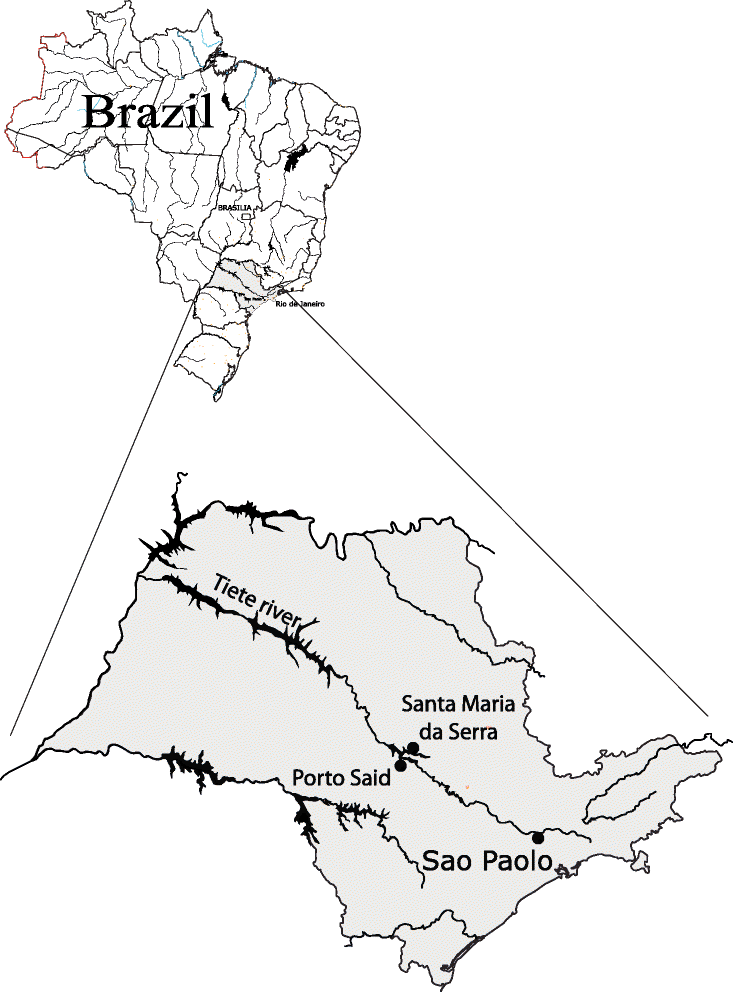Molecular characterization of intestinal protozoa in two poor communities in the State of São Paulo, Brazil
- PMID: 25889093
- PMCID: PMC4335703
- DOI: 10.1186/s13071-015-0714-8
Molecular characterization of intestinal protozoa in two poor communities in the State of São Paulo, Brazil
Abstract
Background: Several species of protozoa cause acute or chronic gastroenteritis in humans, worldwide. The burden of disease is particularly high among children living in developing areas of the world, where transmission is favored by lower hygienic standards and scarce availability of safe water. However, asymptomatic infection and polyparasitism are also commonly observed in poor settings. Here, we investigated the prevalence of intestinal protozoa in two small fishing villages, Porto Said (PS) and Santa Maria da Serra (SM), situated along the river Tietê in the State of São Paolo, Brazil. The villages lack basic public infrastructure and services, such as roads, public water supply, electricity and public health services.
Methods: Multiple fecal samples were collected from 88 individuals in PS and from 38 individuals in SM, who were asymptomatic at the time of sampling and had no recent history of diarrheal disease. To gain insights into potential transmission routes, 49 dog fecal samples (38 from PS and 11 from SM) and 28 river water samples were also collected. All samples were tested by microscopy and PCR was used to genotype Giardia duodenalis, Blastocystis sp., Dientamoeba fragilis and Cryptosporidium spp.
Results: By molecular methods, the most common human parasite was Blastocystis sp. (prevalence, 45% in PS and 71% in SM), followed by D. fragilis (13.6% in PS, and 18.4% in SM) and G. duodenalis (18.2% in PS and 7.9% in SM); Cryptosporidium spp. were not detected. Sequence analysis revealed large genetic variation among Blastocystis samples, with subtypes (STs) 1 and 3 being predominant, and with the notable absence of ST4. Among G. duodenalis samples, assemblages A and B were detected in humans, whereas assemblages A, C and D were found in dogs. Finally, all D. fragilis samples from humans were genotype 1. A single dog was found infected with Cryptosporidium canis. River water samples were negative for the investigated parasites.
Conclusions: This study showed a high carriage of intestinal parasites in asymptomatic individuals from two poor Brazilian villages, and highlighted a large genetic variability of Blastocystis spp. and G. duodenalis.
Figures
Similar articles
-
Intestinal parasite infections in a rural community of Rio de Janeiro (Brazil): Prevalence and genetic diversity of Blastocystis subtypes.PLoS One. 2018 Mar 9;13(3):e0193860. doi: 10.1371/journal.pone.0193860. eCollection 2018. PLoS One. 2018. PMID: 29522552 Free PMC article.
-
Prevalence and Risk Factors for Intestinal Protozoan Infections with Cryptosporidium, Giardia, Blastocystis and Dientamoeba among Schoolchildren in Tripoli, Lebanon.PLoS Negl Trop Dis. 2016 Mar 14;10(3):e0004496. doi: 10.1371/journal.pntd.0004496. eCollection 2016 Mar. PLoS Negl Trop Dis. 2016. PMID: 26974335 Free PMC article.
-
Prevalence of intestinal parasites, with emphasis on the molecular epidemiology of Giardia duodenalis and Blastocystis sp., in the Paranaguá Bay, Brazil: a community survey.Parasit Vectors. 2018 Aug 30;11(1):490. doi: 10.1186/s13071-018-3054-7. Parasit Vectors. 2018. PMID: 30165880 Free PMC article.
-
[Intestinal infections caused by Dientamoeba fragilis and Giardia duodenalis in our experience].Recenti Prog Med. 2007 Jun;98(6):361-6. Recenti Prog Med. 2007. PMID: 17580529 Review. Italian.
-
Dientamoeba fragilis, One of the Neglected Intestinal Protozoa.J Clin Microbiol. 2016 Sep;54(9):2243-50. doi: 10.1128/JCM.00400-16. Epub 2016 Apr 6. J Clin Microbiol. 2016. PMID: 27053676 Free PMC article. Review.
Cited by
-
Occurrence and genotypes of Cryptosporidium spp., Giardia duodenalis, and Blastocystis sp. in household, shelter, breeding, and pet market dogs in Guangzhou, southern China.Sci Rep. 2020 Oct 20;10(1):17736. doi: 10.1038/s41598-020-74299-z. Sci Rep. 2020. PMID: 33082394 Free PMC article.
-
Spatial and Molecular Epidemiology of Giardia intestinalis Deep in the Amazon, Brazil.PLoS One. 2016 Jul 8;11(7):e0158805. doi: 10.1371/journal.pone.0158805. eCollection 2016. PLoS One. 2016. PMID: 27392098 Free PMC article. Clinical Trial.
-
Molecular epidemiology of Giardia duodenalis infection in humans in Southern Ethiopia: a triosephosphate isomerase gene-targeted analysis.Infect Dis Poverty. 2018 Mar 5;7(1):17. doi: 10.1186/s40249-018-0397-4. Infect Dis Poverty. 2018. PMID: 29502512 Free PMC article.
-
Intestinal parasite infections in a rural community of Rio de Janeiro (Brazil): Prevalence and genetic diversity of Blastocystis subtypes.PLoS One. 2018 Mar 9;13(3):e0193860. doi: 10.1371/journal.pone.0193860. eCollection 2018. PLoS One. 2018. PMID: 29522552 Free PMC article.
-
A summary of Blastocystis subtypes in North and South America.Parasit Vectors. 2019 Jul 29;12(1):376. doi: 10.1186/s13071-019-3641-2. Parasit Vectors. 2019. PMID: 31358042 Free PMC article. Review.
References
-
- Lander RL, Lander AG, Houghton L, Williams SM, Costa-Ribeiro H, Barreto DL, et al. Factors influencing growth and intestinal parasitic infections in preschoolers attending philanthropic daycare centers in Salvador, Northeast Region of Brazil. Cad Saúde Pública. 2012;28:2177–88. doi: 10.1590/S0102-311X2012001100017. - DOI - PubMed
Publication types
MeSH terms
LinkOut - more resources
Full Text Sources
Other Literature Sources
Molecular Biology Databases
Miscellaneous


